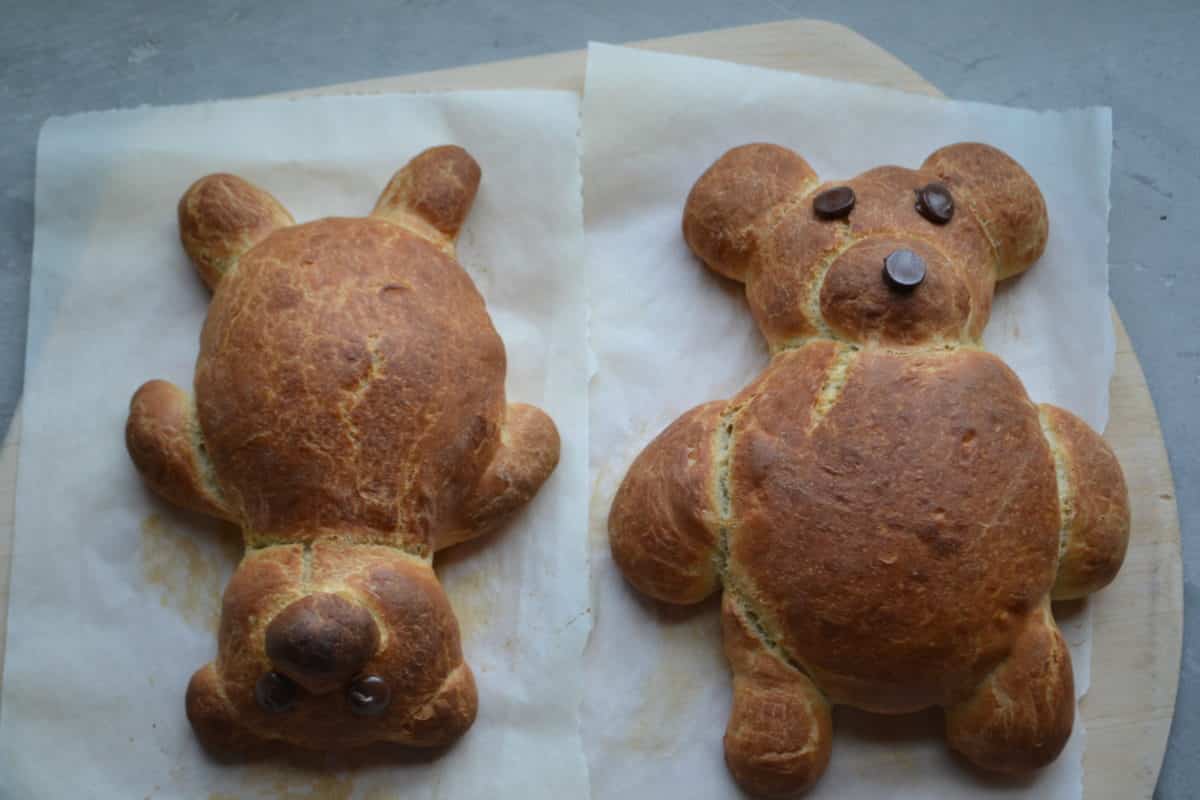This simple basic white bread recipe eliminates eggs both in the dough and as a wash, which is convenient when working with younger children.
Ingredients
- •1 package (.25 ounce each) active dry yeast
- •1 1/2 cups water, warm (about 110° Fahrenheit)
- •3 tablespoons sugar
- •1/2 cup milk, warm (about 110° Fahrenheit)
- •3 tablespoons butter, softened
- •2 teaspoons salt
- •5 cups bread flour (plus up to 1 additional cup for kneading)
- •1 teaspoon vegetable oil
- •3 tablespoons butter, melted
- •Optional: raisins or chocolate chips
Hints: Make the dough in advance for a party or use thawed, frozen bread dough. Pre-portion it so you are ready to go and kids do not have to wait. Even if you use pre-made dough at your party, make a batch of dough anyway so kids can see how bread dough is made. Want to avoid a mess with very young cooks? This recipe will work as “bread in a bag.” Pour all the ingredients into a zipper top plastic bag, squeeze out the air, put inside another plastic bag and knead that! Ask kids to use their senses. What do they see, smell and feel? How do their observations help them stay on track as cooks?


Preparation
How you do it: In a large mixing bowl, gently whisk together yeast, water and sugar until dissolved. [This is an opportunity to explain to young cooks that yeast is a living organism, and that its waste actually is what gives bread its rise.]
Add milk, butter, salt and about half of the flour. Combine ingredients using a spatula or wooden spoon. Gradually add more flour until dough forms. [This is an opportunity to talk about measuring versus making a judgment as a cook. All ingredients should be measured before baking begins (and can be part of the hands-on cooking process with kid volunteers), yet the flour is an imprecise measurement. Ask young cooks how they might decide when enough flour has been added.]
Turn the dough out onto a solid surface dusted with flour and knead for 6 to 8 minutes. [This is an opportunity to demonstrate how to knead and to talk about how the action develops gluten in the dough.]
Oil a bowl, place the dough inside, and coat dough with oil. Cover with a clean dish towel or plastic wrap and place in a warm spot to rise for an hour. [This is an excellent opportunity to clean up and prepare work area for shaping dough. Individual pieces of parchment paper or small foil pans are ideal and can be labeled with names using permanent marker.]
Punch down risen dough and knead gently. Cut into four pieces to make four bears.
To shape into bears: Split each piece of dough in half and make one half into a large oval to form the bear’s body. Split the other piece into two pieces – one for the head, and one for arms and legs. Take the piece for the head and divide it into four parts: one large for the face, and three small to form ears and nose. Take the piece for limbs and separate into four parts of equal size, rolling them into logs.
Build bears directly on parchment paper or foil pan. Let rise for about 15 minutes; meanwhile, preheat oven to 400° F.
Brush with melted butter and bake until golden brown, 17 to 20 minutes.
Use chocolate chips or raisins as eyes and a nose, inserted into small openings cut after bread has cooled slightly.
Jill was a classroom teacher for over a decade, and that experience informs how she writes for and cooks with kids. She offers the following questions to keep in mind when cooking with and writing for children:
1. What is the appropriate age range for this recipe?
2. What skills will be needed?
3. What are the ingredients?
4. What are the steps?
5. How long does it take from start to finish?
6. What equipment is needed?
7. What would be appropriate accompaniments to this dish?
8. What are the history and ethnicity of this food?
9. What fun facts are related to this food?
10. What science facts are related to this food?
11. Do the ingredients or tools introduce new vocabulary?

